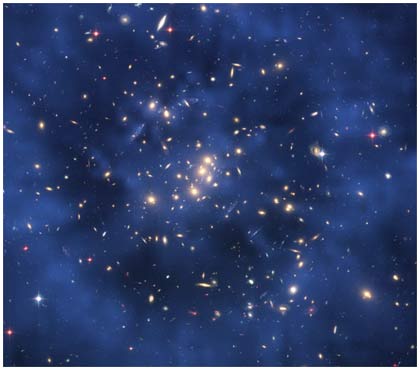Detecting a ring of dark matter
Astronomers say they have documented the best evidence so far about the existence of dark matter, located 5 billion light-years away in the collision of two galactic groups.
As its name suggests, dark matter does not reflect or release any light, but it takes up most of the universe's mass. Astronomers have long suspected that the very existence of this invisible material created additional gravitational pull, helping to pull the galaxies closer together. Because of the common sense, galaxies will drift apart from each other if they are only attracted by the gravitational force of the visible stars.
Astronomers unknowingly discovered this dark matter belt while using the Hubble Space Telescope to map the path of light from distant objects, bent by a named galaxy cluster. ZwC10024 + 1652 .
To observe dark matter, one must use indirect means of monitoring the light being bent, caused by its gravitational pull.
This belt is described as a circular ripple in the light emanating from the galaxy constellation. It is more similar to the trembling image that is observed on a lake when a stone is thrown and interferes with the image of the pebble at the bottom of the lake.
"Dark matter is transparent water and pebbles are part of the background," said Dr. Myungkook James Jee from Johns Hopkins University, a member of the research team.

This dark matter belt is so wide that light must travel 2.6 million years to pass through.(Photo: NASA, ESA)
Why is dark matter pushed into a ring?
The researchers found the answer with a computer simulation of the collision of two galaxy constellations. Accordingly, when they get bored, dark matter falls into the center, and then turns backwards. During this turn, it slows down because of the gravitational pull of the material around him. That creates a traffic jam of dark matter, causing them to get caught in the form of a ring.
From the earth, we see it as a ring, because we are observing the collision above the head, rather than from the side."We see a ring structure separate from galaxies," Jee said.
T. An
- Balance the earth again
- Detecting dark matter fibers
- New explanation of the origin of dark matter
- 11 mysteries about dark matter have not been answered yet
- Found signs of dark matter
- Revealing the first image of dark matter
- The race to find dark matter is heating up
- Earth is losing dark matter
- The mystery of dark matter has been decoded?
- The first image of the dark matter network, which connects galaxies together
- Interesting new technology helps explore dark matter
- $ 9.2 million detector looking for dark matter failed
 Van Allen's belt and evidence that the Apollo 11 mission to the Moon was myth
Van Allen's belt and evidence that the Apollo 11 mission to the Moon was myth The levels of civilization in the universe (Kardashev scale)
The levels of civilization in the universe (Kardashev scale) Today Mars, the sun and the Earth are aligned
Today Mars, the sun and the Earth are aligned The Amazon owner announced a secret plan to build a space base for thousands of people
The Amazon owner announced a secret plan to build a space base for thousands of people